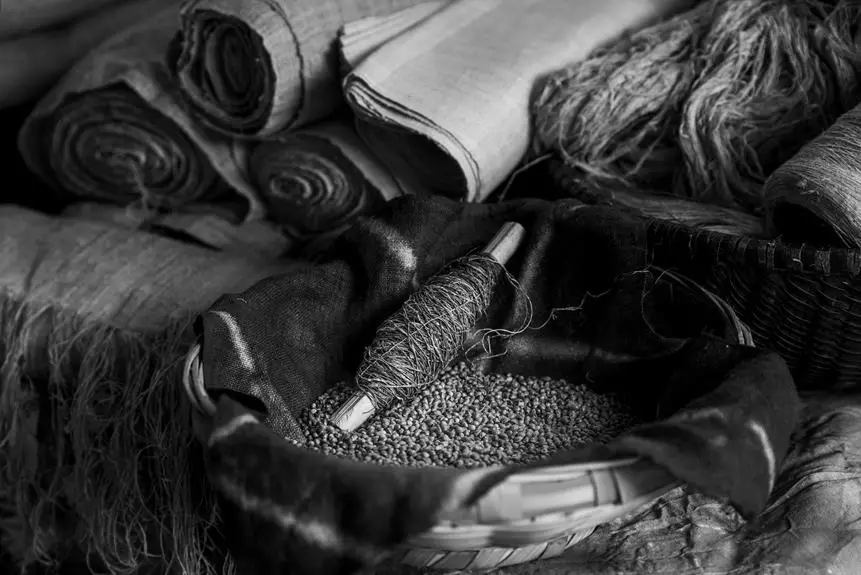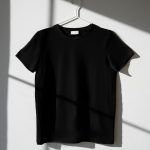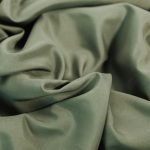When it comes to choosing the right fabric for your next project, you'll find that ponte and crepe each bring unique qualities to the table. Ponte, with its thicker composition and resilience, is perfect for structured pieces, while crepe's lightweight, fluid nature lends itself to more flowing designs. You might be wondering which one aligns better with your vision or which one could elevate your wardrobe. Understanding their key differences and ideal applications can guide you toward making the best choice for fabric that fits your needs. So, let's explore these options further.
Table of Contents
Overview of Ponte Fabric
Ponte fabric is a popular choice for clothing due to its stretchy, structured feel and elegant drape.
You'll find it commonly used in dresses, skirts, and tailored pants, perfect for creating a polished look.
The fabric's blend of polyester, rayon, and spandex gives it both durability and flexibility, making it comfortable to wear for long periods.
When you wear ponte, you'll appreciate how it contours to your body while maintaining its shape, which can be incredibly flattering.
This fabric typically comes in a medium weight, providing just the right amount of support without being overly stiff.
You can also trust that ponte resists wrinkling and fading, making it ideal for both daily wear and special occasions.
Caring for ponte is a breeze, as it's usually machine washable and quick to dry.
If you're looking for versatile outfits that can take you from day to night, ponte fabric is a great option.
You can easily layer it with blazers or cardigans for a more sophisticated look, or dress it down with casual pieces for a relaxed vibe.
Overview of Crepe Fabric
Crepe fabric offers a distinct texture and flow that contrasts with the structured feel of ponte, making it a favorite choice for garments like blouses and dresses. It's known for its unique crinkled or creased surface, which adds dimensionality and visual interest.
You'll often find crepe made from various fibers, including silk, polyester, and rayon, each providing different drapes and feels.
When you wear crepe, you'll notice how it drapes beautifully, hugging your curves while allowing for ease of movement. This attribute makes it an ideal option for flowing maxi dresses or elegant evening wear.
The fabric's lightweight nature also contributes to its breathability, making it perfect for warmer climates or layered looks.
Additionally, crepe is relatively low-maintenance; it typically resists wrinkles, so you can pack it for travel without fearing oversized creases upon arrival.
Whether you're dressing up for an event or seeking chic office wear, crepe provides versatility in styling. Since it's available in a myriad of colors and patterns, you can easily find the perfect match for your wardrobe.
Embrace crepe and elevate your fashion game with its elegant charm!
Key Differences Between Ponte and Crepe
When comparing ponte and crepe, you'll quickly notice their contrasting structures and how each fabric influences the fit and drape of garments. Ponte is thicker and more structured, often providing a body-hugging silhouette that retains its shape. This makes ponte an excellent choice for tailored pieces or outfits that benefit from a form-fitting look.
In contrast, crepe is lighter and has a more fluid drape, giving garments a softer, relaxed appearance.
Ponte's composition often includes a blend of polyester, rayon, and spandex, contributing to its stretchy and forgiving nature.
On the other hand, crepe typically features a more varied fiber content, including silk or polyester, yielding a slightly crinkled texture that enhances its movement.
In terms of breathability, crepe excels, making it suitable for warmer weather or draped styles.
While ponte can be worn year-round, it may feel heavier during hot months.
Finally, the maintenance of these fabrics differs: ponte is usually easier to care for, while crepe may require more delicate handling due to its texture.
Ideal Uses for Ponte
For form-fitting garments that showcase your silhouette, ponte is an ideal choice due to its structured and stretchy nature. When you're looking to create stylish and flattering pieces, ponte's versatility can't be overstated.
- Dresses: Ponte is perfect for creating bodycon dresses that hug your curves without feeling restrictive. Its weight helps to smooth out imperfections, making you feel confident.
- Trousers: Whether you're opting for fitted trousers or tailored leggings, ponte's stretch ensures comfort and flexibility. You can easily transition from casual to professional looks with this fabric.
- Blazers: A ponte blazer can elevate your outfit, offering a structured yet comfortable fit. It works well for layering during the colder months or as a polished finish for any outfit.
Incorporating ponte into your wardrobe guarantees you'll have pieces that not only look amazing but also provide ease of movement. Embrace this fabric's advantages to create stunning, functional clothing you'll love to wear.
Ideal Uses for Crepe
Crepe is incredibly versatile, making it a fantastic choice for a variety of elegant and flowing garments. This lightweight fabric drapes beautifully, so it's perfect for dresses that require a soft, feminine touch. Think evening gowns or cocktail dresses—crepe's ability to create graceful silhouettes will elevate your look.
Crepe's unique texture adds depth to its appearance, making it a go-to for blouses and skirts. You can easily wear a crepe top to the office or dress it up for a night out. Its breathability ensures comfort throughout the day, which is essential for busy schedules.
Additionally, crepe works great for tailored trousers and jumpsuits. The fabric's fluidity provides a sophisticated vibe while allowing for ease of movement. Whether you're going for a polished or casual look, crepe adapts well to any style.
Don't overlook crepe in outerwear, either. Lightweight crepe jackets can add a chic layer to your outfit without bulk. When you select crepe for your next sewing project, you're opting for a fabric that'll bring elegance and versatility to your wardrobe.
Frequently Asked Questions
How Do I Care for Ponte and Crepe Fabrics?
To care for ponte and crepe fabrics, wash them gently on a cold setting, avoid bleach, and air dry when possible. Iron on low heat if needed, ensuring you protect the fabric's texture and integrity.
Can Ponte and Crepe Be Blended With Other Materials?
Yes, ponte and crepe can be blended with other materials. You'll often find them mixed with cotton, polyester, or spandex, which enhances their durability, stretch, and draping qualities for versatile clothing options.
What Are the Best Sewing Techniques for Ponte and Crepe?
When sewing, choose a stretch stitch or serger for ponte to maintain elasticity. For crepe, a straight stitch with a shorter length works best. Always use the right needle and press seams gently for a polished finish.
How Do Weight and Drape Differ in Ponte and Crepe?
When considering weight and drape, you'll notice ponte's heavier, structured feel, creating clean lines. In contrast, crepe's lighter weight and fluid drape provide softness and movement, allowing for a more relaxed silhouette in your projects.
Are There Specific Brands Known for Quality Ponte and Crepe Fabrics?
If you're looking for quality ponte and crepe fabrics, consider brands like Mood Fabrics or Joann. They've got great options that ensure durability and style, making your sewing projects stand out beautifully without breaking the bank.
- Natural Cotton Scrim: An Eco-Friendly Choice for Theatre and Apparel - June 26, 2025
- A Guide to Lighting Scrim Fabric for Film and Photography - June 26, 2025
- Composite Laid Scrims: The Future of Lightweight Reinforcement - June 26, 2025







